Human Resource Development Report: Training Event Analysis & Planning
VerifiedAdded on 2020/06/06
|19
|5702
|105
Report
AI Summary
This report examines Human Resource Development (HRD) within the context of a UK-based HR consultancy, "People 'R' Us." It begins by comparing different learning styles (pragmatists, activists, theorists, and reflectors) and the significance of the learning curve in employee development. The report then delves into training needs analysis at various organizational levels, including management, customer service, and operational staff, highlighting the advantages and disadvantages of different training methods such as performance appraisal, role-playing, and discussions. It further explores the planning of effective training events, considering learning theories and styles, and evaluates training event effectiveness using suitable techniques. The report concludes by discussing the role of government in employee development, the impact of the competency movement, and specific training initiatives by the UK government.
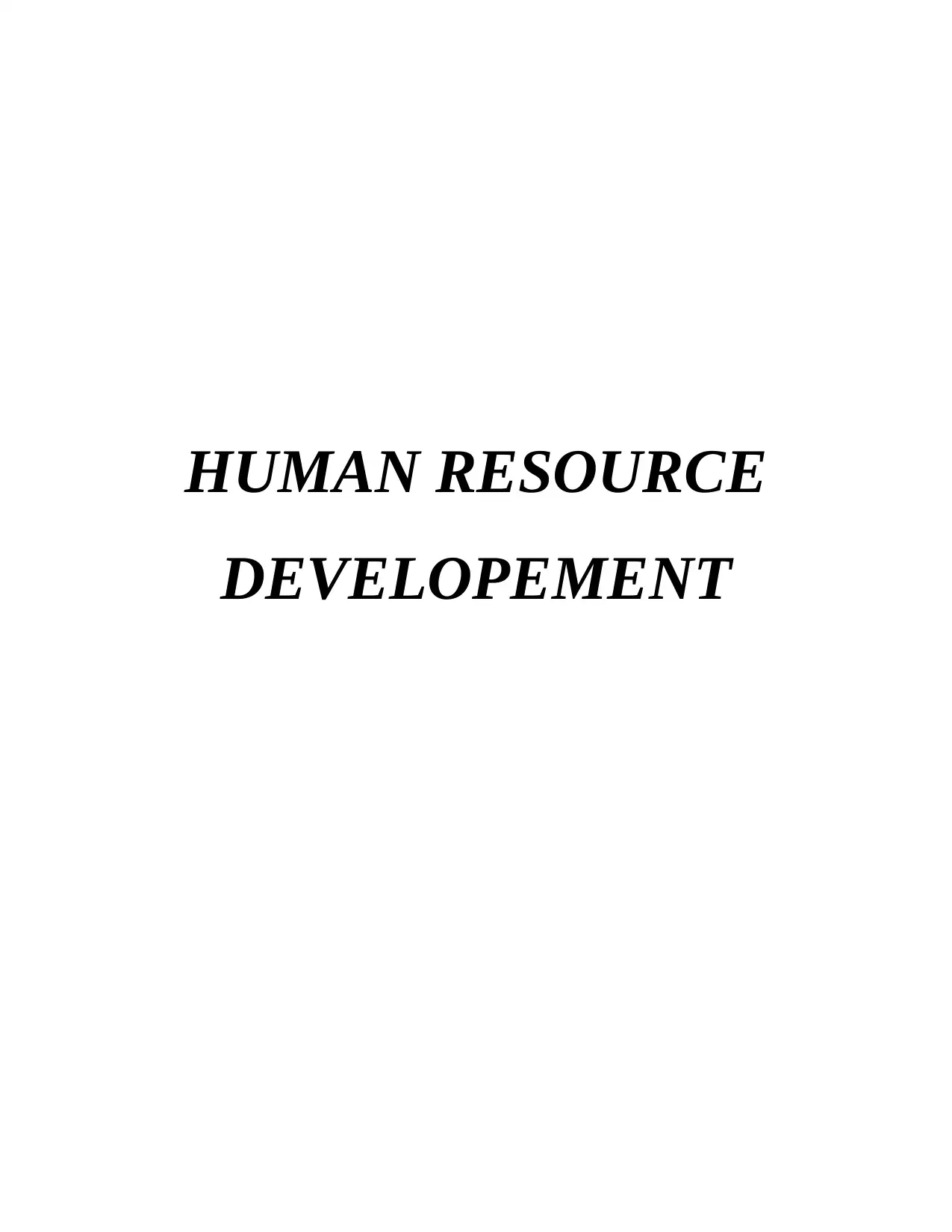
HUMAN RESOURCE
DEVELOPEMENT
DEVELOPEMENT
Paraphrase This Document
Need a fresh take? Get an instant paraphrase of this document with our AI Paraphraser
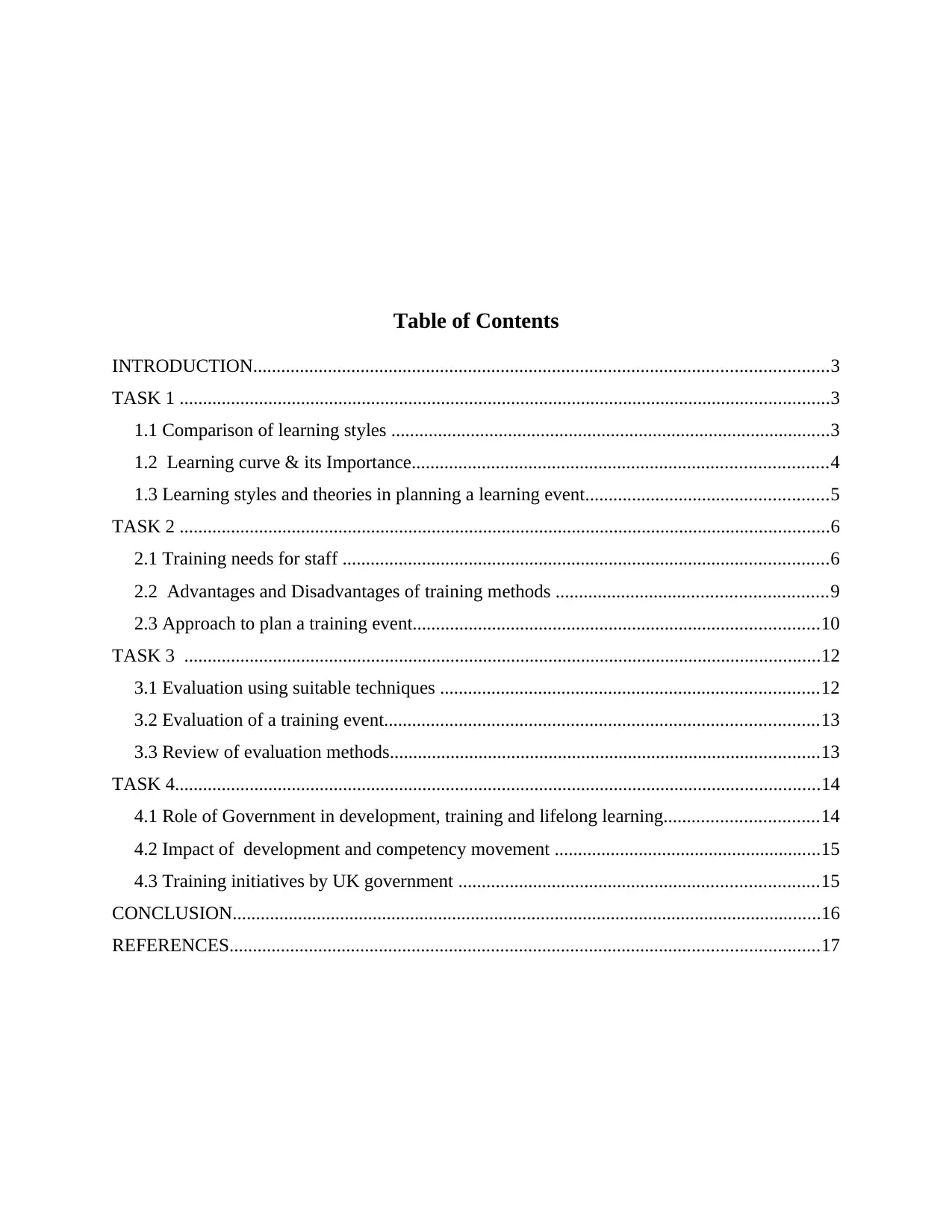
Table of Contents
INTRODUCTION...........................................................................................................................3
TASK 1 ...........................................................................................................................................3
1.1 Comparison of learning styles ..............................................................................................3
1.2 Learning curve & its Importance.........................................................................................4
1.3 Learning styles and theories in planning a learning event....................................................5
TASK 2 ...........................................................................................................................................6
2.1 Training needs for staff ........................................................................................................6
2.2 Advantages and Disadvantages of training methods ..........................................................9
2.3 Approach to plan a training event.......................................................................................10
TASK 3 ........................................................................................................................................12
3.1 Evaluation using suitable techniques .................................................................................12
3.2 Evaluation of a training event.............................................................................................13
3.3 Review of evaluation methods............................................................................................13
TASK 4..........................................................................................................................................14
4.1 Role of Government in development, training and lifelong learning.................................14
4.2 Impact of development and competency movement .........................................................15
4.3 Training initiatives by UK government .............................................................................15
CONCLUSION..............................................................................................................................16
REFERENCES..............................................................................................................................17
INTRODUCTION...........................................................................................................................3
TASK 1 ...........................................................................................................................................3
1.1 Comparison of learning styles ..............................................................................................3
1.2 Learning curve & its Importance.........................................................................................4
1.3 Learning styles and theories in planning a learning event....................................................5
TASK 2 ...........................................................................................................................................6
2.1 Training needs for staff ........................................................................................................6
2.2 Advantages and Disadvantages of training methods ..........................................................9
2.3 Approach to plan a training event.......................................................................................10
TASK 3 ........................................................................................................................................12
3.1 Evaluation using suitable techniques .................................................................................12
3.2 Evaluation of a training event.............................................................................................13
3.3 Review of evaluation methods............................................................................................13
TASK 4..........................................................................................................................................14
4.1 Role of Government in development, training and lifelong learning.................................14
4.2 Impact of development and competency movement .........................................................15
4.3 Training initiatives by UK government .............................................................................15
CONCLUSION..............................................................................................................................16
REFERENCES..............................................................................................................................17
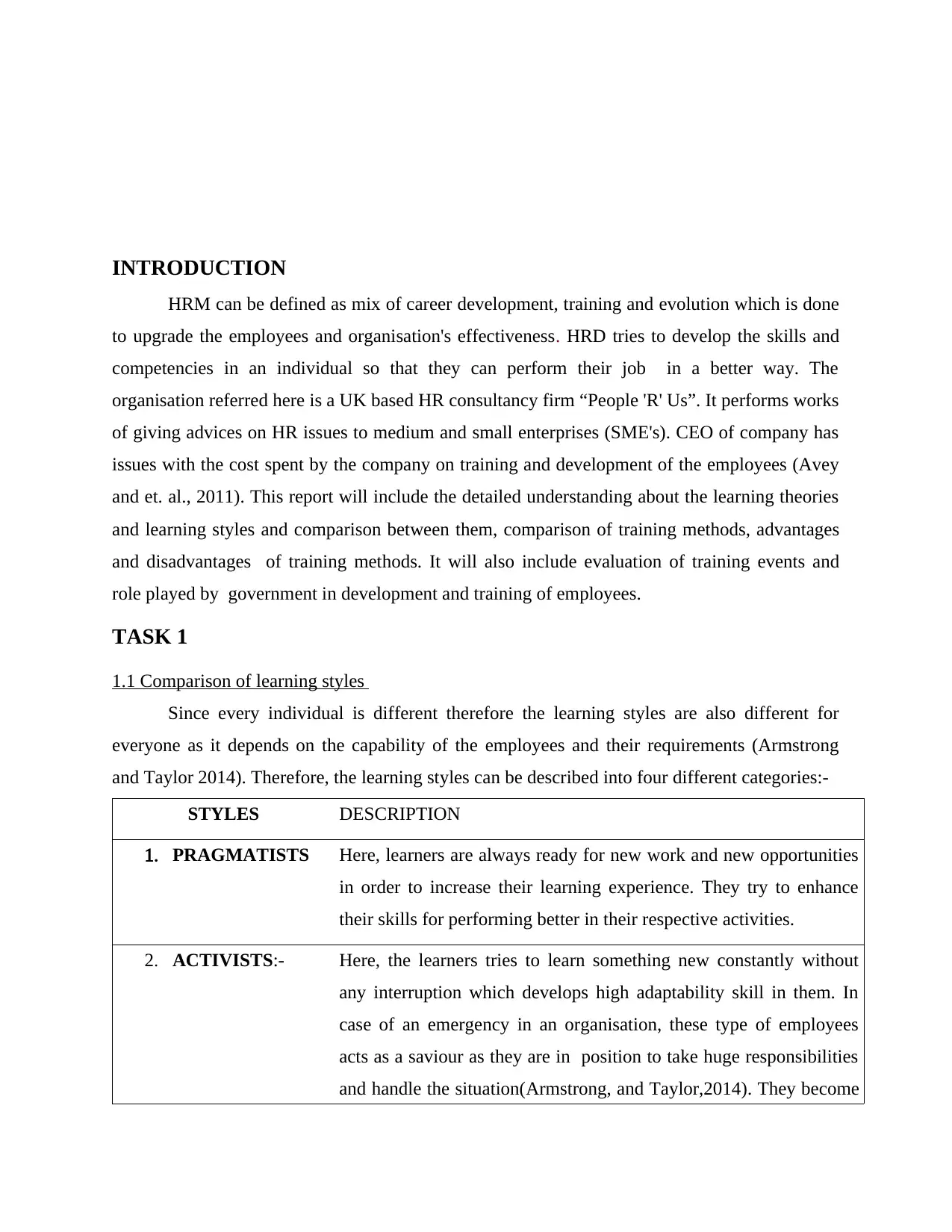
INTRODUCTION
HRM can be defined as mix of career development, training and evolution which is done
to upgrade the employees and organisation's effectiveness. HRD tries to develop the skills and
competencies in an individual so that they can perform their job in a better way. The
organisation referred here is a UK based HR consultancy firm “People 'R' Us”. It performs works
of giving advices on HR issues to medium and small enterprises (SME's). CEO of company has
issues with the cost spent by the company on training and development of the employees (Avey
and et. al., 2011). This report will include the detailed understanding about the learning theories
and learning styles and comparison between them, comparison of training methods, advantages
and disadvantages of training methods. It will also include evaluation of training events and
role played by government in development and training of employees.
TASK 1
1.1 Comparison of learning styles
Since every individual is different therefore the learning styles are also different for
everyone as it depends on the capability of the employees and their requirements (Armstrong
and Taylor 2014). Therefore, the learning styles can be described into four different categories:-
STYLES DESCRIPTION
1. PRAGMATISTS Here, learners are always ready for new work and new opportunities
in order to increase their learning experience. They try to enhance
their skills for performing better in their respective activities.
2. ACTIVISTS:- Here, the learners tries to learn something new constantly without
any interruption which develops high adaptability skill in them. In
case of an emergency in an organisation, these type of employees
acts as a saviour as they are in position to take huge responsibilities
and handle the situation(Armstrong, and Taylor,2014). They become
HRM can be defined as mix of career development, training and evolution which is done
to upgrade the employees and organisation's effectiveness. HRD tries to develop the skills and
competencies in an individual so that they can perform their job in a better way. The
organisation referred here is a UK based HR consultancy firm “People 'R' Us”. It performs works
of giving advices on HR issues to medium and small enterprises (SME's). CEO of company has
issues with the cost spent by the company on training and development of the employees (Avey
and et. al., 2011). This report will include the detailed understanding about the learning theories
and learning styles and comparison between them, comparison of training methods, advantages
and disadvantages of training methods. It will also include evaluation of training events and
role played by government in development and training of employees.
TASK 1
1.1 Comparison of learning styles
Since every individual is different therefore the learning styles are also different for
everyone as it depends on the capability of the employees and their requirements (Armstrong
and Taylor 2014). Therefore, the learning styles can be described into four different categories:-
STYLES DESCRIPTION
1. PRAGMATISTS Here, learners are always ready for new work and new opportunities
in order to increase their learning experience. They try to enhance
their skills for performing better in their respective activities.
2. ACTIVISTS:- Here, the learners tries to learn something new constantly without
any interruption which develops high adaptability skill in them. In
case of an emergency in an organisation, these type of employees
acts as a saviour as they are in position to take huge responsibilities
and handle the situation(Armstrong, and Taylor,2014). They become
⊘ This is a preview!⊘
Do you want full access?
Subscribe today to unlock all pages.

Trusted by 1+ million students worldwide
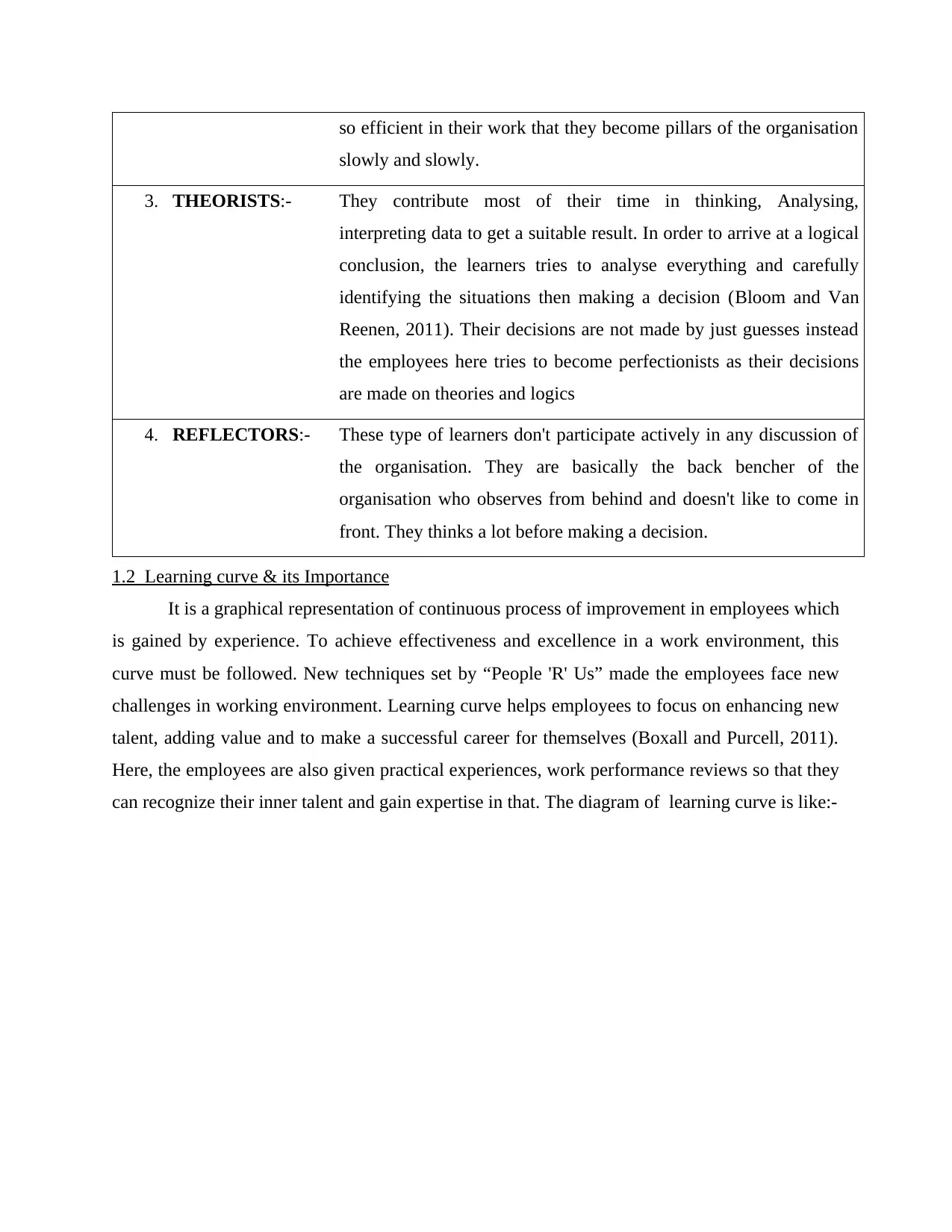
so efficient in their work that they become pillars of the organisation
slowly and slowly.
3. THEORISTS:- They contribute most of their time in thinking, Analysing,
interpreting data to get a suitable result. In order to arrive at a logical
conclusion, the learners tries to analyse everything and carefully
identifying the situations then making a decision (Bloom and Van
Reenen, 2011). Their decisions are not made by just guesses instead
the employees here tries to become perfectionists as their decisions
are made on theories and logics
4. REFLECTORS:- These type of learners don't participate actively in any discussion of
the organisation. They are basically the back bencher of the
organisation who observes from behind and doesn't like to come in
front. They thinks a lot before making a decision.
1.2 Learning curve & its Importance
It is a graphical representation of continuous process of improvement in employees which
is gained by experience. To achieve effectiveness and excellence in a work environment, this
curve must be followed. New techniques set by “People 'R' Us” made the employees face new
challenges in working environment. Learning curve helps employees to focus on enhancing new
talent, adding value and to make a successful career for themselves (Boxall and Purcell, 2011).
Here, the employees are also given practical experiences, work performance reviews so that they
can recognize their inner talent and gain expertise in that. The diagram of learning curve is like:-
slowly and slowly.
3. THEORISTS:- They contribute most of their time in thinking, Analysing,
interpreting data to get a suitable result. In order to arrive at a logical
conclusion, the learners tries to analyse everything and carefully
identifying the situations then making a decision (Bloom and Van
Reenen, 2011). Their decisions are not made by just guesses instead
the employees here tries to become perfectionists as their decisions
are made on theories and logics
4. REFLECTORS:- These type of learners don't participate actively in any discussion of
the organisation. They are basically the back bencher of the
organisation who observes from behind and doesn't like to come in
front. They thinks a lot before making a decision.
1.2 Learning curve & its Importance
It is a graphical representation of continuous process of improvement in employees which
is gained by experience. To achieve effectiveness and excellence in a work environment, this
curve must be followed. New techniques set by “People 'R' Us” made the employees face new
challenges in working environment. Learning curve helps employees to focus on enhancing new
talent, adding value and to make a successful career for themselves (Boxall and Purcell, 2011).
Here, the employees are also given practical experiences, work performance reviews so that they
can recognize their inner talent and gain expertise in that. The diagram of learning curve is like:-
Paraphrase This Document
Need a fresh take? Get an instant paraphrase of this document with our AI Paraphraser
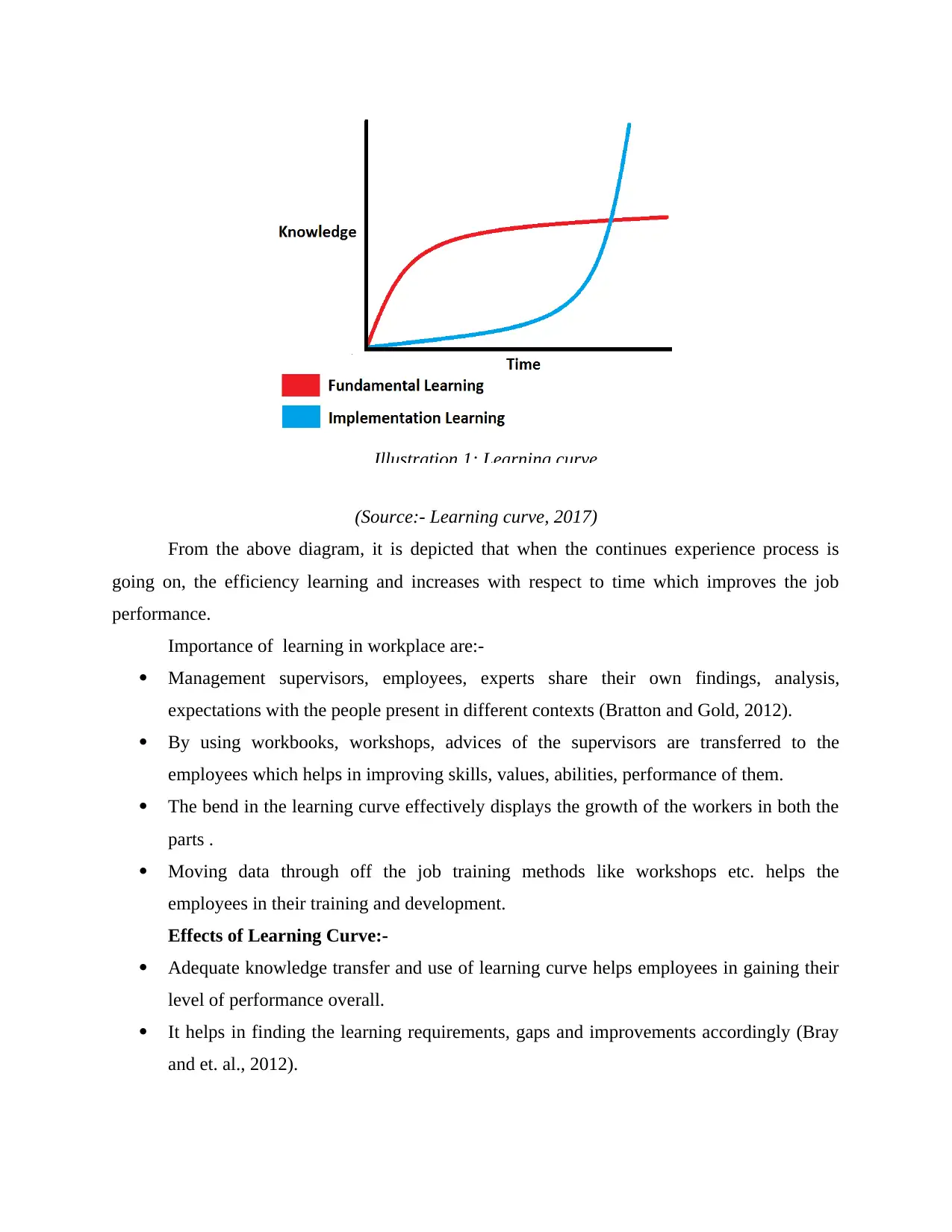
(Source:- Learning curve, 2017)
From the above diagram, it is depicted that when the continues experience process is
going on, the efficiency learning and increases with respect to time which improves the job
performance.
Importance of learning in workplace are:-
Management supervisors, employees, experts share their own findings, analysis,
expectations with the people present in different contexts (Bratton and Gold, 2012).
By using workbooks, workshops, advices of the supervisors are transferred to the
employees which helps in improving skills, values, abilities, performance of them.
The bend in the learning curve effectively displays the growth of the workers in both the
parts .
Moving data through off the job training methods like workshops etc. helps the
employees in their training and development.
Effects of Learning Curve:-
Adequate knowledge transfer and use of learning curve helps employees in gaining their
level of performance overall.
It helps in finding the learning requirements, gaps and improvements accordingly (Bray
and et. al., 2012).
Illustration 1: Learning curve
From the above diagram, it is depicted that when the continues experience process is
going on, the efficiency learning and increases with respect to time which improves the job
performance.
Importance of learning in workplace are:-
Management supervisors, employees, experts share their own findings, analysis,
expectations with the people present in different contexts (Bratton and Gold, 2012).
By using workbooks, workshops, advices of the supervisors are transferred to the
employees which helps in improving skills, values, abilities, performance of them.
The bend in the learning curve effectively displays the growth of the workers in both the
parts .
Moving data through off the job training methods like workshops etc. helps the
employees in their training and development.
Effects of Learning Curve:-
Adequate knowledge transfer and use of learning curve helps employees in gaining their
level of performance overall.
It helps in finding the learning requirements, gaps and improvements accordingly (Bray
and et. al., 2012).
Illustration 1: Learning curve
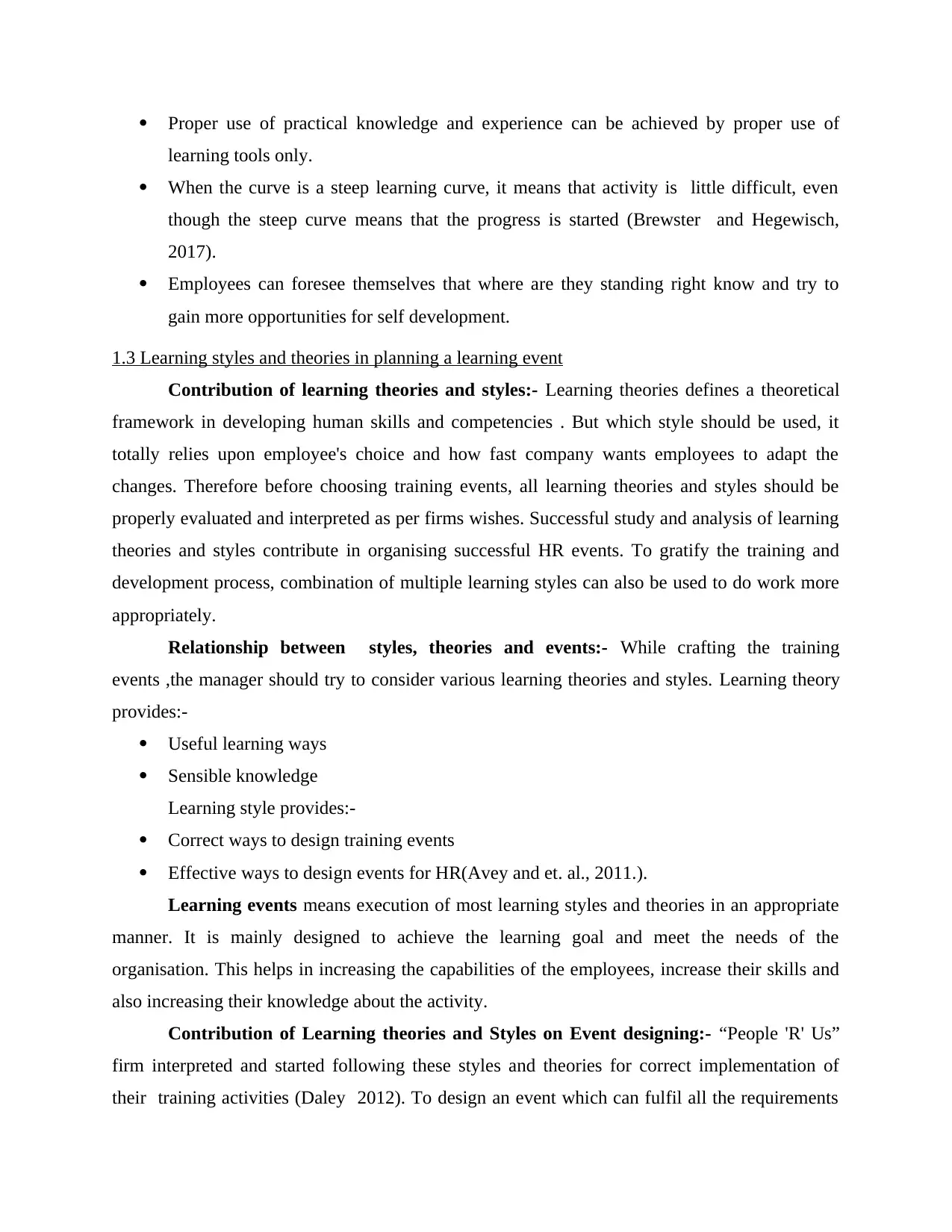
Proper use of practical knowledge and experience can be achieved by proper use of
learning tools only.
When the curve is a steep learning curve, it means that activity is little difficult, even
though the steep curve means that the progress is started (Brewster and Hegewisch,
2017).
Employees can foresee themselves that where are they standing right know and try to
gain more opportunities for self development.
1.3 Learning styles and theories in planning a learning event
Contribution of learning theories and styles:- Learning theories defines a theoretical
framework in developing human skills and competencies . But which style should be used, it
totally relies upon employee's choice and how fast company wants employees to adapt the
changes. Therefore before choosing training events, all learning theories and styles should be
properly evaluated and interpreted as per firms wishes. Successful study and analysis of learning
theories and styles contribute in organising successful HR events. To gratify the training and
development process, combination of multiple learning styles can also be used to do work more
appropriately.
Relationship between styles, theories and events:- While crafting the training
events ,the manager should try to consider various learning theories and styles. Learning theory
provides:-
Useful learning ways
Sensible knowledge
Learning style provides:-
Correct ways to design training events
Effective ways to design events for HR(Avey and et. al., 2011.).
Learning events means execution of most learning styles and theories in an appropriate
manner. It is mainly designed to achieve the learning goal and meet the needs of the
organisation. This helps in increasing the capabilities of the employees, increase their skills and
also increasing their knowledge about the activity.
Contribution of Learning theories and Styles on Event designing:- “People 'R' Us”
firm interpreted and started following these styles and theories for correct implementation of
their training activities (Daley 2012). To design an event which can fulfil all the requirements
learning tools only.
When the curve is a steep learning curve, it means that activity is little difficult, even
though the steep curve means that the progress is started (Brewster and Hegewisch,
2017).
Employees can foresee themselves that where are they standing right know and try to
gain more opportunities for self development.
1.3 Learning styles and theories in planning a learning event
Contribution of learning theories and styles:- Learning theories defines a theoretical
framework in developing human skills and competencies . But which style should be used, it
totally relies upon employee's choice and how fast company wants employees to adapt the
changes. Therefore before choosing training events, all learning theories and styles should be
properly evaluated and interpreted as per firms wishes. Successful study and analysis of learning
theories and styles contribute in organising successful HR events. To gratify the training and
development process, combination of multiple learning styles can also be used to do work more
appropriately.
Relationship between styles, theories and events:- While crafting the training
events ,the manager should try to consider various learning theories and styles. Learning theory
provides:-
Useful learning ways
Sensible knowledge
Learning style provides:-
Correct ways to design training events
Effective ways to design events for HR(Avey and et. al., 2011.).
Learning events means execution of most learning styles and theories in an appropriate
manner. It is mainly designed to achieve the learning goal and meet the needs of the
organisation. This helps in increasing the capabilities of the employees, increase their skills and
also increasing their knowledge about the activity.
Contribution of Learning theories and Styles on Event designing:- “People 'R' Us”
firm interpreted and started following these styles and theories for correct implementation of
their training activities (Daley 2012). To design an event which can fulfil all the requirements
⊘ This is a preview!⊘
Do you want full access?
Subscribe today to unlock all pages.

Trusted by 1+ million students worldwide
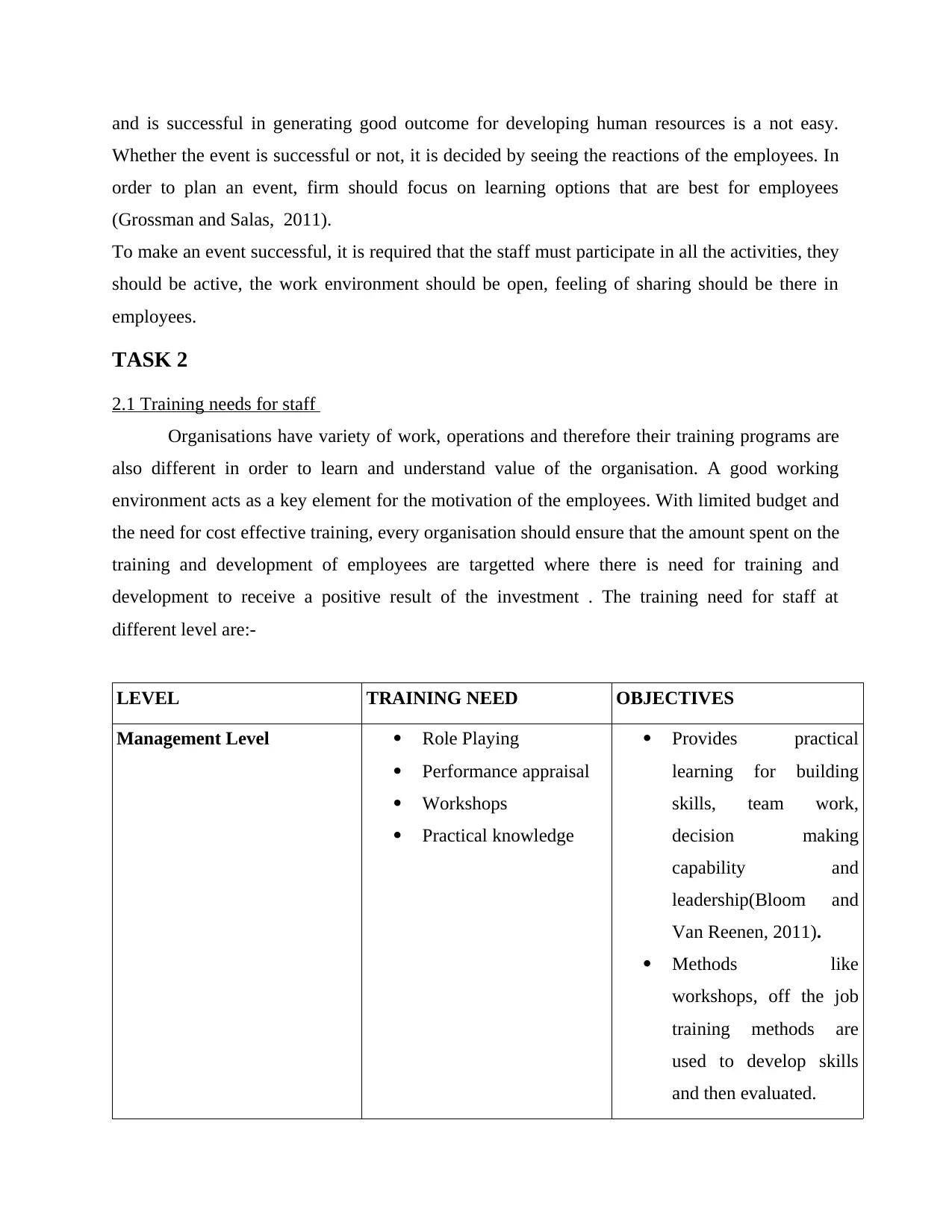
and is successful in generating good outcome for developing human resources is a not easy.
Whether the event is successful or not, it is decided by seeing the reactions of the employees. In
order to plan an event, firm should focus on learning options that are best for employees
(Grossman and Salas, 2011).
To make an event successful, it is required that the staff must participate in all the activities, they
should be active, the work environment should be open, feeling of sharing should be there in
employees.
TASK 2
2.1 Training needs for staff
Organisations have variety of work, operations and therefore their training programs are
also different in order to learn and understand value of the organisation. A good working
environment acts as a key element for the motivation of the employees. With limited budget and
the need for cost effective training, every organisation should ensure that the amount spent on the
training and development of employees are targetted where there is need for training and
development to receive a positive result of the investment . The training need for staff at
different level are:-
LEVEL TRAINING NEED OBJECTIVES
Management Level Role Playing
Performance appraisal
Workshops
Practical knowledge
Provides practical
learning for building
skills, team work,
decision making
capability and
leadership(Bloom and
Van Reenen, 2011).
Methods like
workshops, off the job
training methods are
used to develop skills
and then evaluated.
Whether the event is successful or not, it is decided by seeing the reactions of the employees. In
order to plan an event, firm should focus on learning options that are best for employees
(Grossman and Salas, 2011).
To make an event successful, it is required that the staff must participate in all the activities, they
should be active, the work environment should be open, feeling of sharing should be there in
employees.
TASK 2
2.1 Training needs for staff
Organisations have variety of work, operations and therefore their training programs are
also different in order to learn and understand value of the organisation. A good working
environment acts as a key element for the motivation of the employees. With limited budget and
the need for cost effective training, every organisation should ensure that the amount spent on the
training and development of employees are targetted where there is need for training and
development to receive a positive result of the investment . The training need for staff at
different level are:-
LEVEL TRAINING NEED OBJECTIVES
Management Level Role Playing
Performance appraisal
Workshops
Practical knowledge
Provides practical
learning for building
skills, team work,
decision making
capability and
leadership(Bloom and
Van Reenen, 2011).
Methods like
workshops, off the job
training methods are
used to develop skills
and then evaluated.
Paraphrase This Document
Need a fresh take? Get an instant paraphrase of this document with our AI Paraphraser
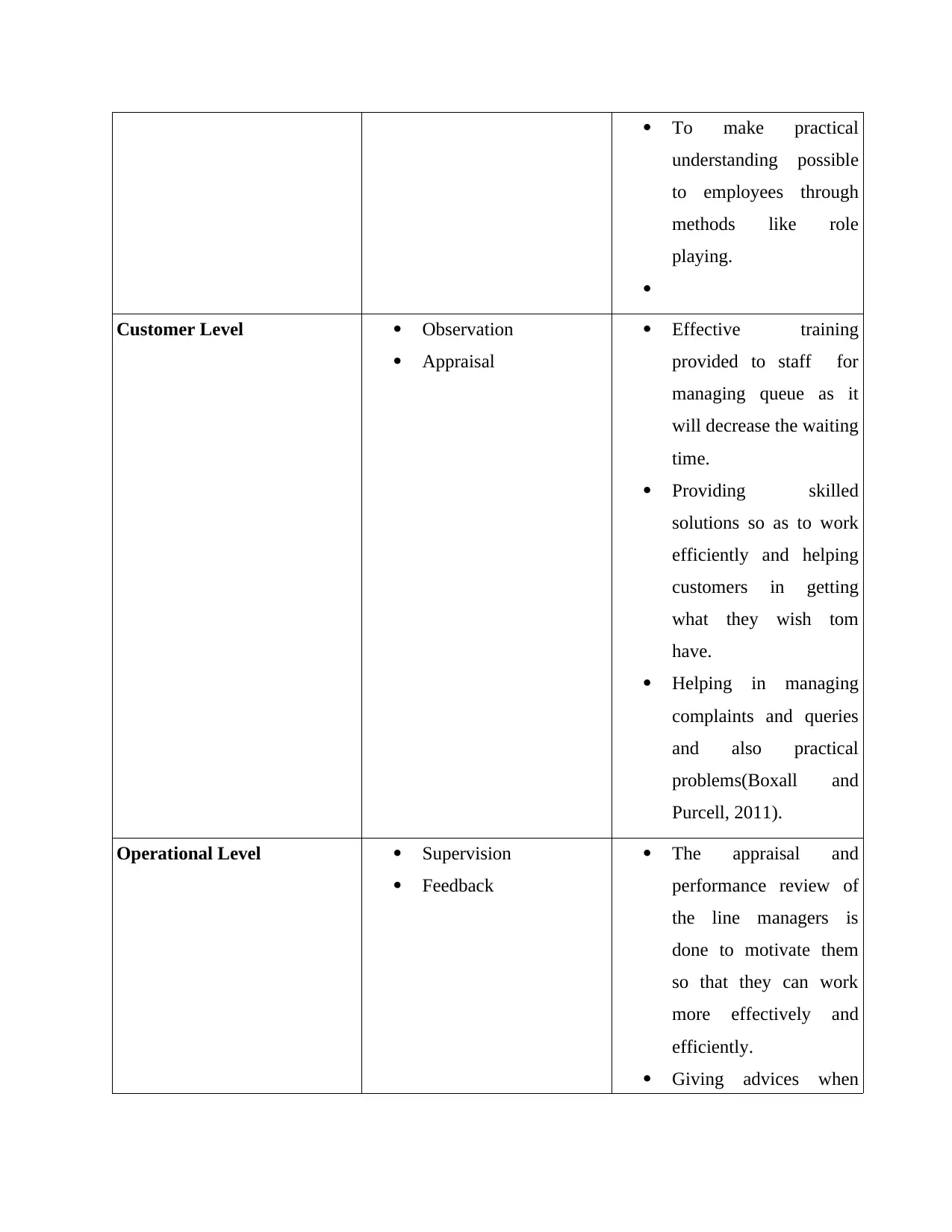
To make practical
understanding possible
to employees through
methods like role
playing.
Customer Level Observation
Appraisal
Effective training
provided to staff for
managing queue as it
will decrease the waiting
time.
Providing skilled
solutions so as to work
efficiently and helping
customers in getting
what they wish tom
have.
Helping in managing
complaints and queries
and also practical
problems(Boxall and
Purcell, 2011).
Operational Level Supervision
Feedback
The appraisal and
performance review of
the line managers is
done to motivate them
so that they can work
more effectively and
efficiently.
Giving advices when
understanding possible
to employees through
methods like role
playing.
Customer Level Observation
Appraisal
Effective training
provided to staff for
managing queue as it
will decrease the waiting
time.
Providing skilled
solutions so as to work
efficiently and helping
customers in getting
what they wish tom
have.
Helping in managing
complaints and queries
and also practical
problems(Boxall and
Purcell, 2011).
Operational Level Supervision
Feedback
The appraisal and
performance review of
the line managers is
done to motivate them
so that they can work
more effectively and
efficiently.
Giving advices when
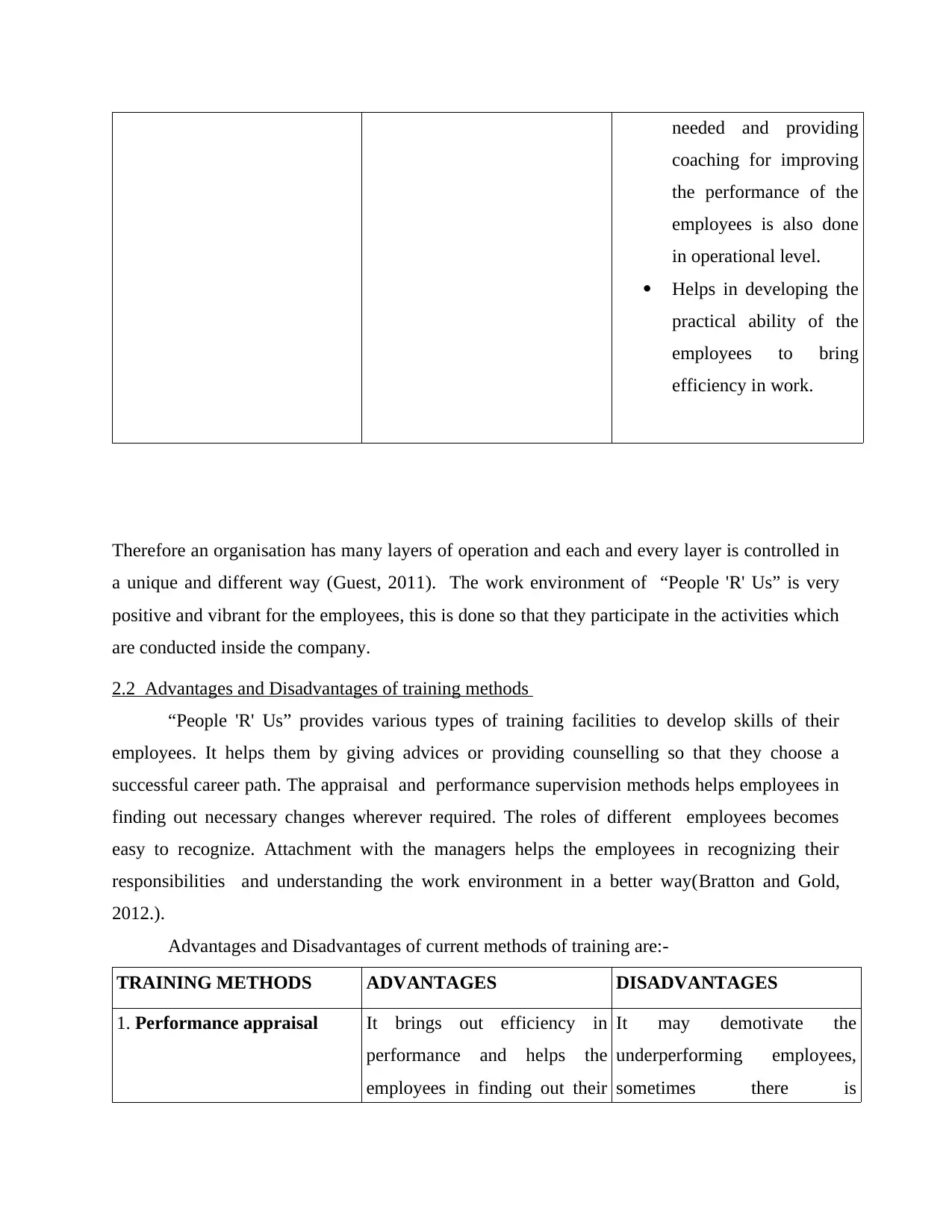
needed and providing
coaching for improving
the performance of the
employees is also done
in operational level.
Helps in developing the
practical ability of the
employees to bring
efficiency in work.
Therefore an organisation has many layers of operation and each and every layer is controlled in
a unique and different way (Guest, 2011). The work environment of “People 'R' Us” is very
positive and vibrant for the employees, this is done so that they participate in the activities which
are conducted inside the company.
2.2 Advantages and Disadvantages of training methods
“People 'R' Us” provides various types of training facilities to develop skills of their
employees. It helps them by giving advices or providing counselling so that they choose a
successful career path. The appraisal and performance supervision methods helps employees in
finding out necessary changes wherever required. The roles of different employees becomes
easy to recognize. Attachment with the managers helps the employees in recognizing their
responsibilities and understanding the work environment in a better way(Bratton and Gold,
2012.).
Advantages and Disadvantages of current methods of training are:-
TRAINING METHODS ADVANTAGES DISADVANTAGES
1. Performance appraisal It brings out efficiency in
performance and helps the
employees in finding out their
It may demotivate the
underperforming employees,
sometimes there is
coaching for improving
the performance of the
employees is also done
in operational level.
Helps in developing the
practical ability of the
employees to bring
efficiency in work.
Therefore an organisation has many layers of operation and each and every layer is controlled in
a unique and different way (Guest, 2011). The work environment of “People 'R' Us” is very
positive and vibrant for the employees, this is done so that they participate in the activities which
are conducted inside the company.
2.2 Advantages and Disadvantages of training methods
“People 'R' Us” provides various types of training facilities to develop skills of their
employees. It helps them by giving advices or providing counselling so that they choose a
successful career path. The appraisal and performance supervision methods helps employees in
finding out necessary changes wherever required. The roles of different employees becomes
easy to recognize. Attachment with the managers helps the employees in recognizing their
responsibilities and understanding the work environment in a better way(Bratton and Gold,
2012.).
Advantages and Disadvantages of current methods of training are:-
TRAINING METHODS ADVANTAGES DISADVANTAGES
1. Performance appraisal It brings out efficiency in
performance and helps the
employees in finding out their
It may demotivate the
underperforming employees,
sometimes there is
⊘ This is a preview!⊘
Do you want full access?
Subscribe today to unlock all pages.

Trusted by 1+ million students worldwide
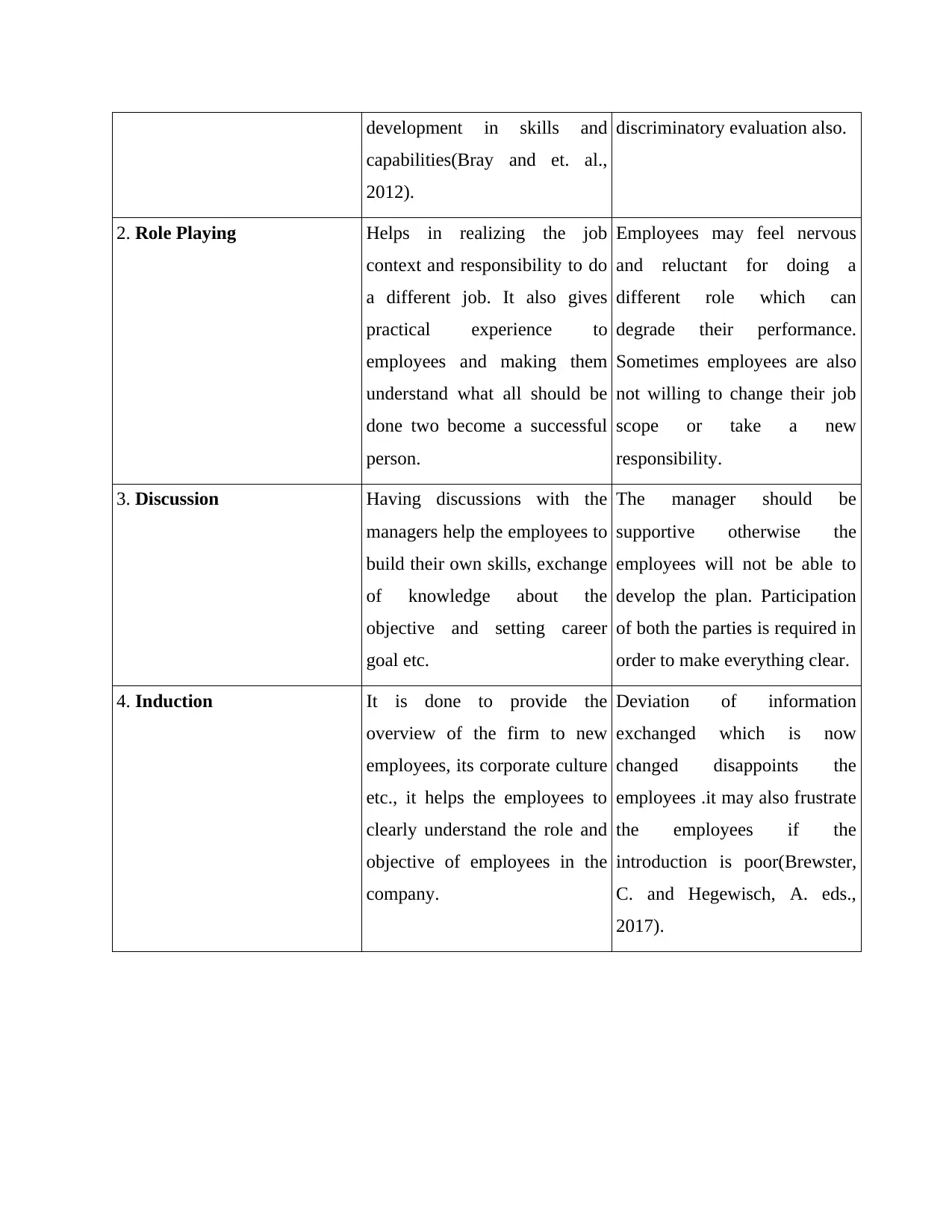
development in skills and
capabilities(Bray and et. al.,
2012).
discriminatory evaluation also.
2. Role Playing Helps in realizing the job
context and responsibility to do
a different job. It also gives
practical experience to
employees and making them
understand what all should be
done two become a successful
person.
Employees may feel nervous
and reluctant for doing a
different role which can
degrade their performance.
Sometimes employees are also
not willing to change their job
scope or take a new
responsibility.
3. Discussion Having discussions with the
managers help the employees to
build their own skills, exchange
of knowledge about the
objective and setting career
goal etc.
The manager should be
supportive otherwise the
employees will not be able to
develop the plan. Participation
of both the parties is required in
order to make everything clear.
4. Induction It is done to provide the
overview of the firm to new
employees, its corporate culture
etc., it helps the employees to
clearly understand the role and
objective of employees in the
company.
Deviation of information
exchanged which is now
changed disappoints the
employees .it may also frustrate
the employees if the
introduction is poor(Brewster,
C. and Hegewisch, A. eds.,
2017).
capabilities(Bray and et. al.,
2012).
discriminatory evaluation also.
2. Role Playing Helps in realizing the job
context and responsibility to do
a different job. It also gives
practical experience to
employees and making them
understand what all should be
done two become a successful
person.
Employees may feel nervous
and reluctant for doing a
different role which can
degrade their performance.
Sometimes employees are also
not willing to change their job
scope or take a new
responsibility.
3. Discussion Having discussions with the
managers help the employees to
build their own skills, exchange
of knowledge about the
objective and setting career
goal etc.
The manager should be
supportive otherwise the
employees will not be able to
develop the plan. Participation
of both the parties is required in
order to make everything clear.
4. Induction It is done to provide the
overview of the firm to new
employees, its corporate culture
etc., it helps the employees to
clearly understand the role and
objective of employees in the
company.
Deviation of information
exchanged which is now
changed disappoints the
employees .it may also frustrate
the employees if the
introduction is poor(Brewster,
C. and Hegewisch, A. eds.,
2017).
Paraphrase This Document
Need a fresh take? Get an instant paraphrase of this document with our AI Paraphraser
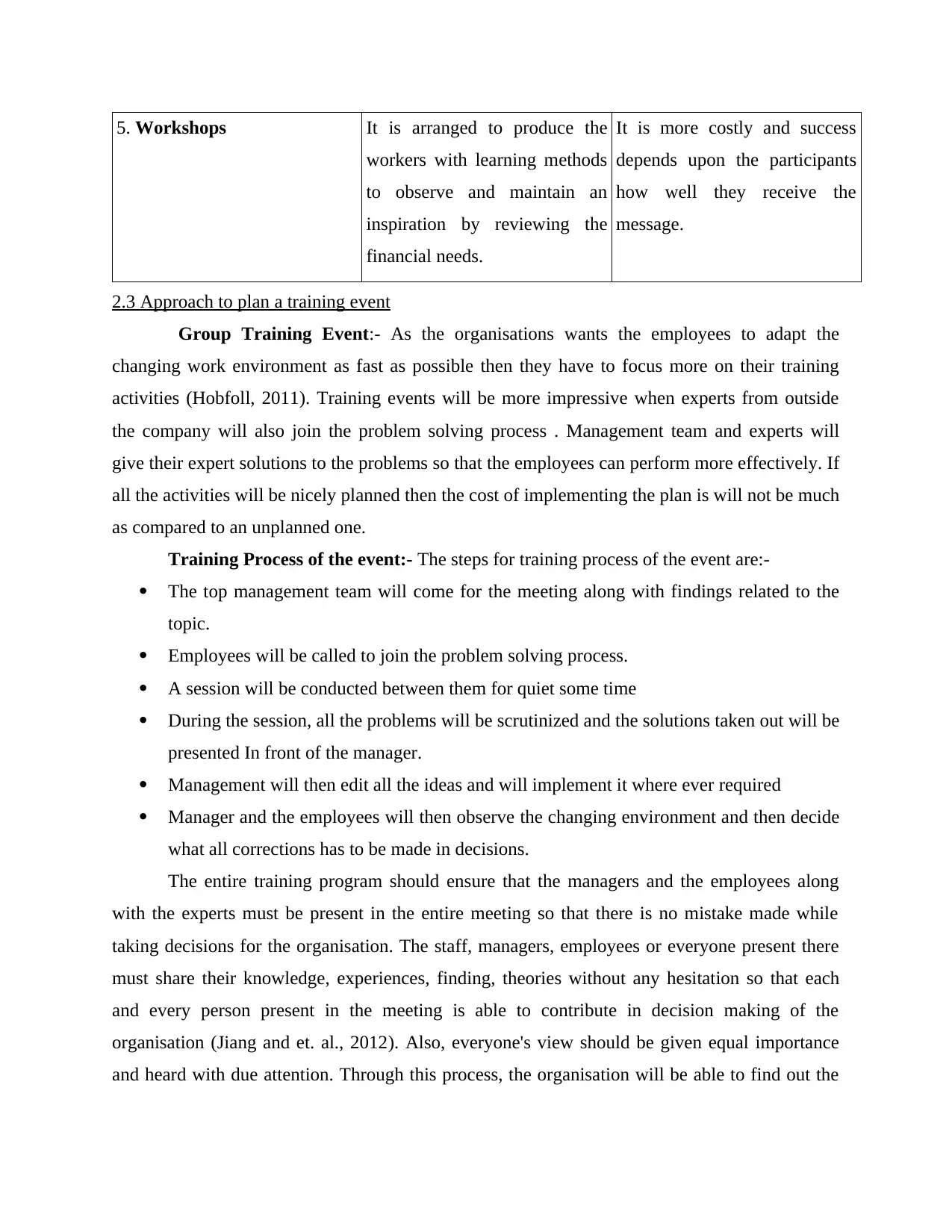
5. Workshops It is arranged to produce the
workers with learning methods
to observe and maintain an
inspiration by reviewing the
financial needs.
It is more costly and success
depends upon the participants
how well they receive the
message.
2.3 Approach to plan a training event
Group Training Event:- As the organisations wants the employees to adapt the
changing work environment as fast as possible then they have to focus more on their training
activities (Hobfoll, 2011). Training events will be more impressive when experts from outside
the company will also join the problem solving process . Management team and experts will
give their expert solutions to the problems so that the employees can perform more effectively. If
all the activities will be nicely planned then the cost of implementing the plan is will not be much
as compared to an unplanned one.
Training Process of the event:- The steps for training process of the event are:-
The top management team will come for the meeting along with findings related to the
topic.
Employees will be called to join the problem solving process.
A session will be conducted between them for quiet some time
During the session, all the problems will be scrutinized and the solutions taken out will be
presented In front of the manager.
Management will then edit all the ideas and will implement it where ever required
Manager and the employees will then observe the changing environment and then decide
what all corrections has to be made in decisions.
The entire training program should ensure that the managers and the employees along
with the experts must be present in the entire meeting so that there is no mistake made while
taking decisions for the organisation. The staff, managers, employees or everyone present there
must share their knowledge, experiences, finding, theories without any hesitation so that each
and every person present in the meeting is able to contribute in decision making of the
organisation (Jiang and et. al., 2012). Also, everyone's view should be given equal importance
and heard with due attention. Through this process, the organisation will be able to find out the
workers with learning methods
to observe and maintain an
inspiration by reviewing the
financial needs.
It is more costly and success
depends upon the participants
how well they receive the
message.
2.3 Approach to plan a training event
Group Training Event:- As the organisations wants the employees to adapt the
changing work environment as fast as possible then they have to focus more on their training
activities (Hobfoll, 2011). Training events will be more impressive when experts from outside
the company will also join the problem solving process . Management team and experts will
give their expert solutions to the problems so that the employees can perform more effectively. If
all the activities will be nicely planned then the cost of implementing the plan is will not be much
as compared to an unplanned one.
Training Process of the event:- The steps for training process of the event are:-
The top management team will come for the meeting along with findings related to the
topic.
Employees will be called to join the problem solving process.
A session will be conducted between them for quiet some time
During the session, all the problems will be scrutinized and the solutions taken out will be
presented In front of the manager.
Management will then edit all the ideas and will implement it where ever required
Manager and the employees will then observe the changing environment and then decide
what all corrections has to be made in decisions.
The entire training program should ensure that the managers and the employees along
with the experts must be present in the entire meeting so that there is no mistake made while
taking decisions for the organisation. The staff, managers, employees or everyone present there
must share their knowledge, experiences, finding, theories without any hesitation so that each
and every person present in the meeting is able to contribute in decision making of the
organisation (Jiang and et. al., 2012). Also, everyone's view should be given equal importance
and heard with due attention. Through this process, the organisation will be able to find out the
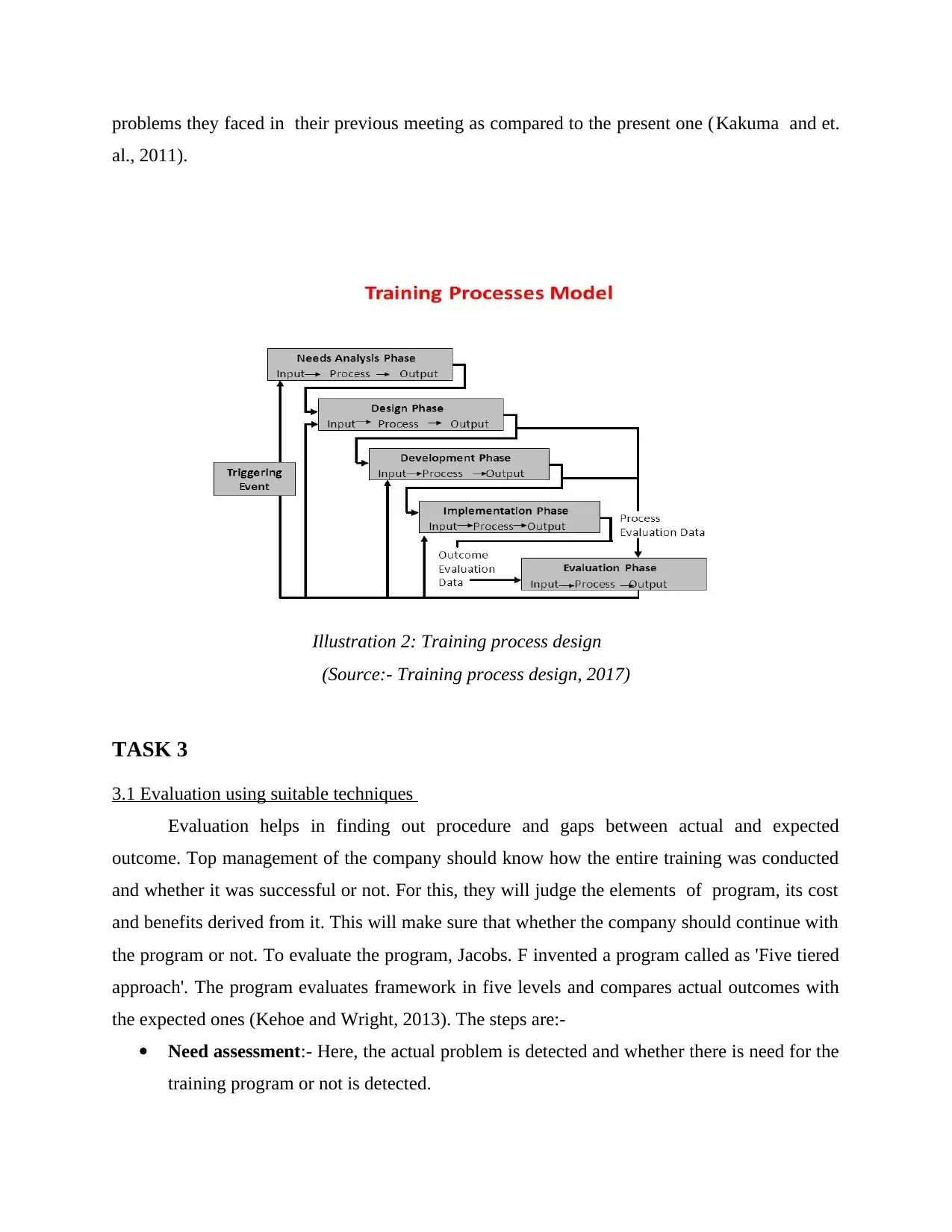
problems they faced in their previous meeting as compared to the present one (Kakuma and et.
al., 2011).
(Source:- Training process design, 2017)
TASK 3
3.1 Evaluation using suitable techniques
Evaluation helps in finding out procedure and gaps between actual and expected
outcome. Top management of the company should know how the entire training was conducted
and whether it was successful or not. For this, they will judge the elements of program, its cost
and benefits derived from it. This will make sure that whether the company should continue with
the program or not. To evaluate the program, Jacobs. F invented a program called as 'Five tiered
approach'. The program evaluates framework in five levels and compares actual outcomes with
the expected ones (Kehoe and Wright, 2013). The steps are:-
Need assessment:- Here, the actual problem is detected and whether there is need for the
training program or not is detected.
Illustration 2: Training process design
al., 2011).
(Source:- Training process design, 2017)
TASK 3
3.1 Evaluation using suitable techniques
Evaluation helps in finding out procedure and gaps between actual and expected
outcome. Top management of the company should know how the entire training was conducted
and whether it was successful or not. For this, they will judge the elements of program, its cost
and benefits derived from it. This will make sure that whether the company should continue with
the program or not. To evaluate the program, Jacobs. F invented a program called as 'Five tiered
approach'. The program evaluates framework in five levels and compares actual outcomes with
the expected ones (Kehoe and Wright, 2013). The steps are:-
Need assessment:- Here, the actual problem is detected and whether there is need for the
training program or not is detected.
Illustration 2: Training process design
⊘ This is a preview!⊘
Do you want full access?
Subscribe today to unlock all pages.

Trusted by 1+ million students worldwide
1 out of 19
Related Documents
Your All-in-One AI-Powered Toolkit for Academic Success.
+13062052269
info@desklib.com
Available 24*7 on WhatsApp / Email
![[object Object]](/_next/static/media/star-bottom.7253800d.svg)
Unlock your academic potential
Copyright © 2020–2025 A2Z Services. All Rights Reserved. Developed and managed by ZUCOL.





